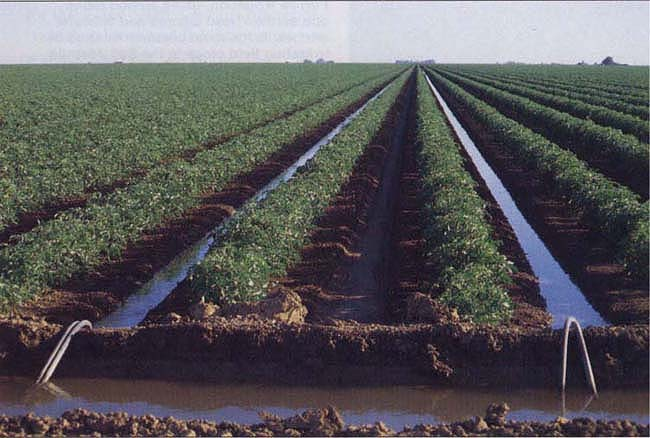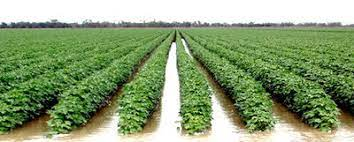Surface irrigation systems are supported by a number of on- and off-farm structures which control and manage the flow and its energy.
1 Diversion structures
2 Conveyance, distribution and management structures
3 Field distribution systems
2 Conveyance, distribution and management structures
3 Field distribution systems
In order to facilitate efficient surface irrigation, these structures should be easily and cheaply constructed as well as easy to manage and maintain. Each should be standardized for mass production and fabrication in the field by farmers and technicians.
It is not the intent of this guide to be comprehensive with regard to the selection and design of these structures since other sources are available, but it is worthwhile to note some of these structures by way of presenting a larger view of surface irrigation.
The structural elements of a surface system perform several important functions which include:
It is not the intent of this guide to be comprehensive with regard to the selection and design of these structures since other sources are available, but it is worthwhile to note some of these structures by way of presenting a larger view of surface irrigation.
The structural elements of a surface system perform several important functions which include:
(1) turning the flow to a field on and off;
(2) conveying and distributing the flow among fields;
(3) water measurement, sediment and debris removal, water level stabilization; and
(4) distribution of water onto the field.
2.4.1 Diversion structures
Most surface irrigation systems derive their water supplies from canal systems operated by public or semi-public irrigation departments, districts, or companies. Some irrigation water is supplied in piped delivery systems and some directly pumped from groundwater.
Most surface irrigation systems derive their water supplies from canal systems operated by public or semi-public irrigation departments, districts, or companies. Some irrigation water is supplied in piped delivery systems and some directly pumped from groundwater.
Diversion structures perform several tasks including
(1) on-off water control which allows the supply agency to allocate its supply and protects the fields below the diversion from untimely flooding;
(2) regulation and stabilization of the discharge to the requirements of field channels and watercourse distribution systems;
(3) measurement of flow at the turnout in order to establish and protect water entitlements; and
(4) protection of downstream structures by controlling sediments and debris as well as dissipating excess kinetic energy in the flow. A typical turnout structure is shown in Figure 7.
Figure 7. Typical turnout from a canal or lateral (from walker end Skogerboe, 1987)

2.4.2 Conveyance, distribution and management structures
Conveying water to the field requires similar structures to those found in major canal networks. The conveyance itself can be an earthen ditch or lateral, a buried pipe, or a lined ditch. Lined sections can be elevated as shown in Figure 8, or constructed at surface level. Pipe materials are usually plastic, steel, concrete, clay, or asbestos cement, or they may be as simple as a wooden or bamboo construction. Lining materials include slip-form cast-in-place, or prefabricated concrete (Figure 9), shotcrete or gunite, asphalt, surface and buried plastic or rubber membranes, and compacted earth.
Figure 8. Elevated concrete channel in Iran
Figure 9. Slip-form concrete lining in the USA
The management of water in the field channels involves flow measurement, sediment and debris removal, divisions, checks, drop-energy dissipators, and water level regulators. Some of the more common flow control structures for open channels are shown in Figure 10. Associated with these are various flow measuring devices like weirs, flumes, and orifices. The designs of these structures have been standardized since they are small in size and capacity. Designs for flow measurement and drop-energy dissipator structures need more attention and construction must be more precise since their hydraulic responses are quite sensitive to their dimensions.
Figure 10. On-farm water management structures (from Skogerboe et al., 1971)
a. a simple drop structure

b. a typical check-divider

2.4.3 Field distribution systems
After the water reaches the field ready to be irrigated, it is distributed onto the field by a variety of means, both simple and elaborately constructed. Most fields have a head ditch or pipeline running along the upper side of the field from which the flow is distributed onto the field.
In a field irrigated from a head ditch, the spreading of water over the field depends somewhat on the method of surface irrigation. For borders and basins, open or piped cutlets as illustrated in Figure 11 are generally used. Furrow systems use outlets which can be directed to each furrow.
Figure 11. Head ditch outlets for borders and basins (after Kraatz and Mahajan, FAO, 1975)

Figure 12 shows a system in which siphon tubes are used as a means of serving each furrow. Field distribution and spreading can also be through portable pipelines running along the surfaces or permanent pipelines running underground. Basins and borders usually receive water through buried pipes serving one or more gated risers within each basin or border. A typical riser outlet, known as an alfalfa valve, is shown in Figure 13. The most common piped method of furrow irrigation uses plastic or aluminium gated pipe like that shown in Figure 14. The gated pipe may be connected to the main water supply via a piped distribution network with a riser assembly like the one shown in Figure 13, directly to a canal turnout, or through an open channel to a piped transition.
Figure 12. Siphons for furrow irrigation
Figure 13. An alfalfa valve riser

Figure 7. Typical turnout from a canal or lateral (from walker end Skogerboe, 1987)

2.4.2 Conveyance, distribution and management structures
Conveying water to the field requires similar structures to those found in major canal networks. The conveyance itself can be an earthen ditch or lateral, a buried pipe, or a lined ditch. Lined sections can be elevated as shown in Figure 8, or constructed at surface level. Pipe materials are usually plastic, steel, concrete, clay, or asbestos cement, or they may be as simple as a wooden or bamboo construction. Lining materials include slip-form cast-in-place, or prefabricated concrete (Figure 9), shotcrete or gunite, asphalt, surface and buried plastic or rubber membranes, and compacted earth.
Figure 8. Elevated concrete channel in Iran
Figure 9. Slip-form concrete lining in the USA
The management of water in the field channels involves flow measurement, sediment and debris removal, divisions, checks, drop-energy dissipators, and water level regulators. Some of the more common flow control structures for open channels are shown in Figure 10. Associated with these are various flow measuring devices like weirs, flumes, and orifices. The designs of these structures have been standardized since they are small in size and capacity. Designs for flow measurement and drop-energy dissipator structures need more attention and construction must be more precise since their hydraulic responses are quite sensitive to their dimensions.
Figure 10. On-farm water management structures (from Skogerboe et al., 1971)
a. a simple drop structure

b. a typical check-divider

2.4.3 Field distribution systems
After the water reaches the field ready to be irrigated, it is distributed onto the field by a variety of means, both simple and elaborately constructed. Most fields have a head ditch or pipeline running along the upper side of the field from which the flow is distributed onto the field.
In a field irrigated from a head ditch, the spreading of water over the field depends somewhat on the method of surface irrigation. For borders and basins, open or piped cutlets as illustrated in Figure 11 are generally used. Furrow systems use outlets which can be directed to each furrow.
Figure 11. Head ditch outlets for borders and basins (after Kraatz and Mahajan, FAO, 1975)

Figure 12 shows a system in which siphon tubes are used as a means of serving each furrow. Field distribution and spreading can also be through portable pipelines running along the surfaces or permanent pipelines running underground. Basins and borders usually receive water through buried pipes serving one or more gated risers within each basin or border. A typical riser outlet, known as an alfalfa valve, is shown in Figure 13. The most common piped method of furrow irrigation uses plastic or aluminium gated pipe like that shown in Figure 14. The gated pipe may be connected to the main water supply via a piped distribution network with a riser assembly like the one shown in Figure 13, directly to a canal turnout, or through an open channel to a piped transition.
Figure 12. Siphons for furrow irrigation
Figure 13. An alfalfa valve riser

















